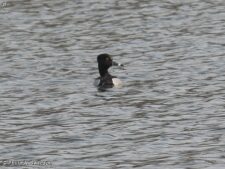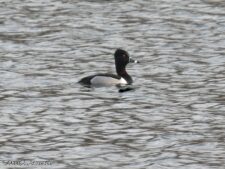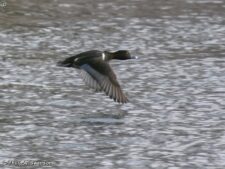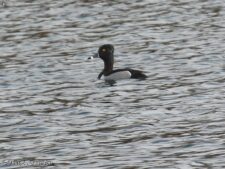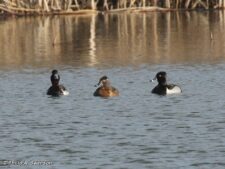
17 inches long with a wingspan of 25 inches. The Ring-necked Duck is a compact diving duck with a peaked crown and a dark wing with grayish flight feathers. The adult male in breeding plumage has a blue bill with a black tip and a white ring just above the tip. There is also a white ring at the base of the bill. The head and neck are purple contrasting with a yellow eye. There is a chestnut ring around the neck, but this is not easily visible. The breast is black and the belly whitish. The back, tail, and undertail coverts are dark. The flanks are gray with a white finger rising up just in front of the folded wings. The female has dark brown body plumage with a dark back. The dark eye has a narrow white eye ring. The face is pale gray with whitish lores and a thin white line extending behind the eye. She also has a dark brown crown. The bill is blue-gray with a less distinct white ring just above the black tip.
The Ring-necked Duck is a somewhat common migrant in the Omaha area and commonly seen in the Great Marsh or flying over the lowlands. The best times are March and April and again in October and November.
The Ring-necked Duck looks like it should have been called a Ring-billed Duck. It prefers shallow, freshwater wetlands with stable water levels and abundant emergent and submerged or floating plants. It dives for its food in shallow water and has a more generalized diet than do other North American diving ducks. Only the female provides parental care, incubating eggs and generally remaining with the young until they fledge.
Disclaimer: The content of NatureSearch is provided by dedicated volunteer Naturalists of Fontenelle Forest who strive to provide the most accurate information available. Contributors of the images retain their copyrights. The point of contact for this page is: Phil Swanson.

